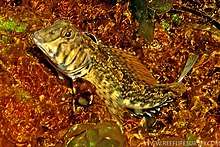Western jumping blenny
Lepidoblennius marmoratus, known commonly as the western jumping blenny, is a species of triplefin blenny in the genus Lepidoblennius.[2] It was first described by William John Macleay in 1878.
| Western jumping blenny | |
|---|---|
 | |
| Scientific classification | |
| Kingdom: | Animalia |
| Phylum: | Chordata |
| Class: | Actinopterygii |
| Order: | Blenniiformes |
| Family: | Tripterygiidae |
| Genus: | Lepidoblennius |
| Species: | L. marmoratus |
| Binomial name | |
| Lepidoblennius marmoratus (W. J. Macleay, 1878) | |
| Synonyms | |
|
Tripterygium marmoratum W. J. Macleay, 1878 | |
Description
The western jumping blenny has a body which is slightly compressed and has a steep snout and a naked head, with no scales.[3] The body is coloured greyish to greenish-grey paler underneath. It is marked with dark vertical lines on the head, lines of small dark spots on the dorsal, caudal and pectoral fins and there are irregular blotches along the flanks.[4] It grows to a maximum standard length of 11.4 centimetres (4.5 in).[2] The western jumping blenny is identified from the allopatric but congeneric eastern jumping blenny by having a deep incision between the last spine of the first dorsal fin and the first spine of the second dorsal fin, as well as having two spines in the anal fin while the eastern has none.[3]
Distribution
The western jumping blenny is endemic to Australia where it occurs on the west and south coasts from 32° south in Western Australia to Kangaroo Island off South Australia.[1] Its northernmost locality is the Swan River.[4]
Habitat and biology
The western jumping blenny is found in tidal pools and in rocky subtidal and intertidal areas.[4] It occurs where there are algal covered rocks.[1] They occur at depths of 0 to 3 metres (0.0 to 9.8 ft).[2] They are frequently encountered out of the water but they can easily return to the water by flicking their tail.[4]
Etymology and taxonomy
William John Macleay described this species in 1878 with a type locality of King George Sound, Western Australia. The generic name means "scaled blenny" while the specific name marmoratus means "marbled" in reference to the yellowish colour mottled with black.[5]
References
- Williams, J. & Holleman, W. (2014). "Lepidoblennius marmoratus". IUCN Red List of Threatened Species. 2014: e.T178947A1551377. doi:10.2305/IUCN.UK.2014-3.RLTS.T178947A1551377.en.
- Froese, Rainer and Pauly, Daniel, eds. (2019). "Lepidoblennius marmoratus" in FishBase. April 2019 version.
- "Western Jumping Blenny, Lepidoblennius marmoratus (Macleay, 1878)". Australian Museum. Retrieved 27 May 2019.
- Dianne J. Bray. "Lepidoblennius marmoratus". Fishes of Australia. Museums Victoria. Retrieved 27 May 2019.
- Christopher Scharpf; Kenneth J. Lazara (29 January 2019). "Order Blenniiformes: Families Tripterygiidae and Dactyloscopidae". The ETYFish Project Fish Name Etymology Database. Christopher Scharpf and Kenneth J. Lazara. Retrieved 27 May 2019.
